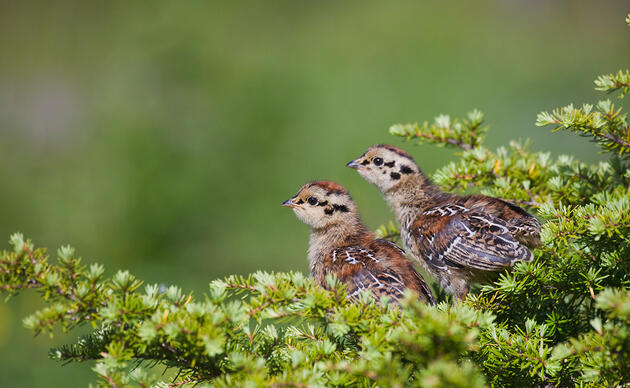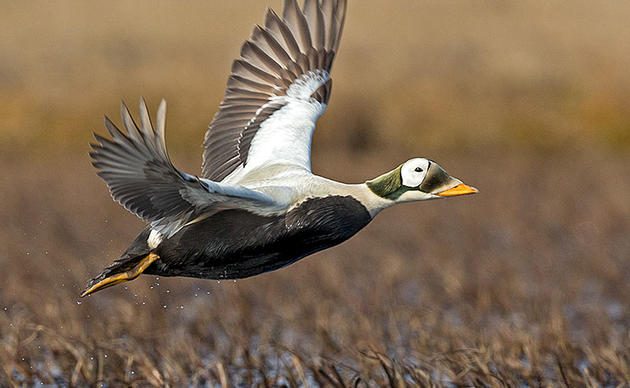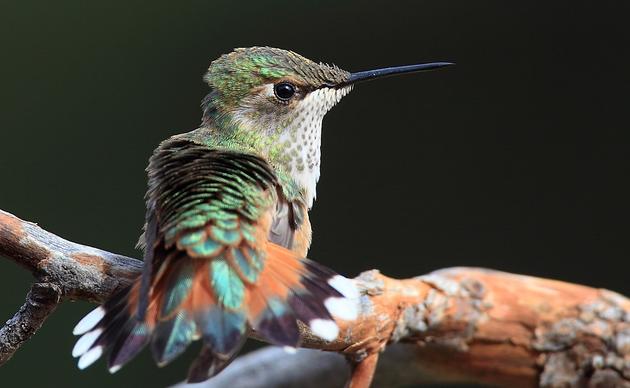Bird Research by Audubon Alaska Staff
2014
MATT KIRCHHOFF
FROM CRITICALLY ENDANGERED TO LEAST CONCERN?—A REVISED POPULATION TREND FOR THE KITTLITZ'S MURRELET IN GLACIER BAY, ALASKA
Recommended Citation: Kirchhoff, M. D.; J. R. Lindell; and J. I. Hodges. 2014. From critically endangered to least concern?—A revised population trend for the Kittlitz’s Murrelet in Glacier Bay, Alaska. The Condor: Ornithological Applications. 116:24–34.
Abstract:
The Kittlitz’s Murrelet (Brachyramphus brevirostris) has been proposed for listing under the U.S. Endangered Species Act, and is classified as critically endangered by the International Union for the Conservation of Nature (IUCN). A significant portion of the global population occurs in Glacier Bay, Alaska, where steep population declines have been previously reported. To further examine Kittlitz’s Murrelet population trends we replicated a 1993 survey in 2009 and 2010 using the same lead observer, the same transect lines, and similar methods. We found the number of Kittlitz’s Murrelets unchanged since 1993. Other seabird surveys were conducted in Glacier Bay between 1991 and 2008 by federal agencies, using a variety of sampling designs. We added our surveys to previously published surveys, correcting for percentage of murrelets identified to species to enable comparison. When all surveys were analyzed collectively, the Kittlitz’s Murrelet population showed no significant trend between 1991 and 2010 (P¼0.51). A power analysis showed high power (.0.99) to detect a decline had the population truly been declining at a rate of_11% per year, allowing us to reject the prior published conclusion of decline rates of_10.7% to_14.4% per year in Glacier Bay. The prior result of murrelet population decline was driven by a high population estimate from an isolated, nonstandard survey in 1991. Our three surveys in 1993, 2009, and 2010 provide a direct long-term comparison of standardized surveys, and show a more comprehensive picture of the Kittlitz’s Murrelet population trend in Glacier Bay. We suggest the previous conclusion of a declining trend was influenced by anchoring bias, which attached undue certainty to the initial observation. The revised population trend in Glacier Bay indicates Kittlitz’s Murrelets are not at imminent risk of extinction.
NILS WARNOCK
ANNUAL MIGRATORY PATTERNS OF LONG-BILLED CURLEWS IN THE AMERICAN WEST
Recommended Citation: Page, G.W., N. Warnock, T. L. Tibbitts, D. Jorgensen, C. A. Hartman, and L. E. Stenzel. 2014. Annual migratory patterns of Long-billed Curlews in the American West. Condor 116:50-61.
Abstract
Effective conservation of migratory species requires comprehensive knowledge of annual movement patterns. Such information is sparse for the Long-billed Curlew (Numenius americanus), a North American endemic shorebird of conservation concern. To test hypotheses about individual and area differences in migratory patterns across western North America, we tagged 29 curlews with satellite transmitters at breeding sites in Oregon, Nevada, and Montana. Transmissions from 28 birds for up to 4 years demonstrated that all wintered within the species’ known winter range, including 9 from Oregon tracked to agricultural areas of California’s Central Valley; 5 from Nevada tracked to the Central Valley, northern Gulf of California, or west coast of Baja California, Mexico; and 14 from Montana that wintered inland, from the Texas Panhandle south to the Mexican Plateau, or near the Gulf of Mexico. Montana breeders migrated east of the Rocky Mountains and traveled more than twice the distance of Oregon and Nevada breeders. Montana birds also stopped more often and longer during most passages. As a group, curlews arrived on their Oregon breeding grounds earlier than in Montana, while males preceded females in Montana and possibly Oregon. No consistent pattern emerged between sexes in departure from breeding areas, although within pairs males departed later than their mates. Individuals exhibited strong fidelity to breeding and wintering sites, and many birds showed a strong propensity for agricultural regions during winter. Our results underscore the importance of studying migration behavior across the breeding range to adequately capture variation in migratory patterns of a species.
2013
NILS WARNOCK
HISTORY OF THE RED-NECKED STINT BREEDING IN NORTH AMERICAS
Recommended Citation: DeCicco, L. H., N. Warnock, and J. A. Johnson. 2013. Breeding history of the Red-necked Stint in North America. Western Birds 44:273–278
ABSTRACT:
The largely palearctic Red-necked Stint has been documented breeding in the Nearctic Region only in Alaska, from which 12 records were published from 1909 to 1975. In summer 2012 we found a family of Red-necked Stints in the Kigluaik Mountains of the Seward Peninsula, in tundra of the dwarf shrub mat type with ≥50% cover of bare rock. The photographs obtained are the first published of the Red-necked Stint breeding in Alaska.
RESIDENCY TIMES AND PATTERNS OF MOVEMENT OF POSTBREEDING DUNLIN ON A SUBARCTIC STAGING AREA IN ALASKA
Recommended Citation: Warnock, N., C. M. Handel, R. E. Gill, Jr., and B. J. McCaffery. 2013. Residency times and patterns of movement of postbreeding dunlin on a subarctic staging area in Alaska. Arctic 66:407-416
Abstract: Understanding how individuals use key resources is critical for effective conservation of a population. The Yukon-Kuskokwim Delta (YKD) in western Alaska is the most important postbreeding staging area for shorebirds in the subarctic North Pacific, yet little is known about movements of shorebirds there during the postbreeding period. To address this information gap, we studied residency times and patterns of movement of 17 adult and 17 juvenile radio-marked Dunlin (Calidris alpina) on the YKD between early August and early October 2005. Throughout this postbreeding period, during which Dunlin were molting, most birds were relocated within a 130 km radius of their capture site on the YKD, but three birds were relocated more than 600 km to the south at estuaries along the Alaska Peninsula. On average, juvenile Dunlin were relocated farther away from the banding site (median relocation distance = 36.3 km) than adult Dunlin (median relocation distance = 8.8 km). Post-capture, minimum lengths of stay by Dunlin on the YKD were not significantly different between juveniles (median = 19 days) and adults (median = 23 days), with some birds staging for more than 50 days. Body mass at time of capture was the best single variable explaining length of stay on the YKD, with average length of stay decreasing by 2.5 days per additional gram of body mass at time of capture. Conservation efforts for postbreeding shorebirds should consider patterns of resource use that may differ not only by age cohort but also by individual condition.
How you can help, right now
Donate to Audubon
Help secure the future for birds at risk from climate change, habitat loss and other threats. Your support will power our science, education, advocacy and on-the-ground conservation efforts.
1% for the Planet
We are proud to be part of the 1% for the Planet network. If you own a business, please consider joining 1% for the Planet to support Audubon Alaska’s conservation efforts.




